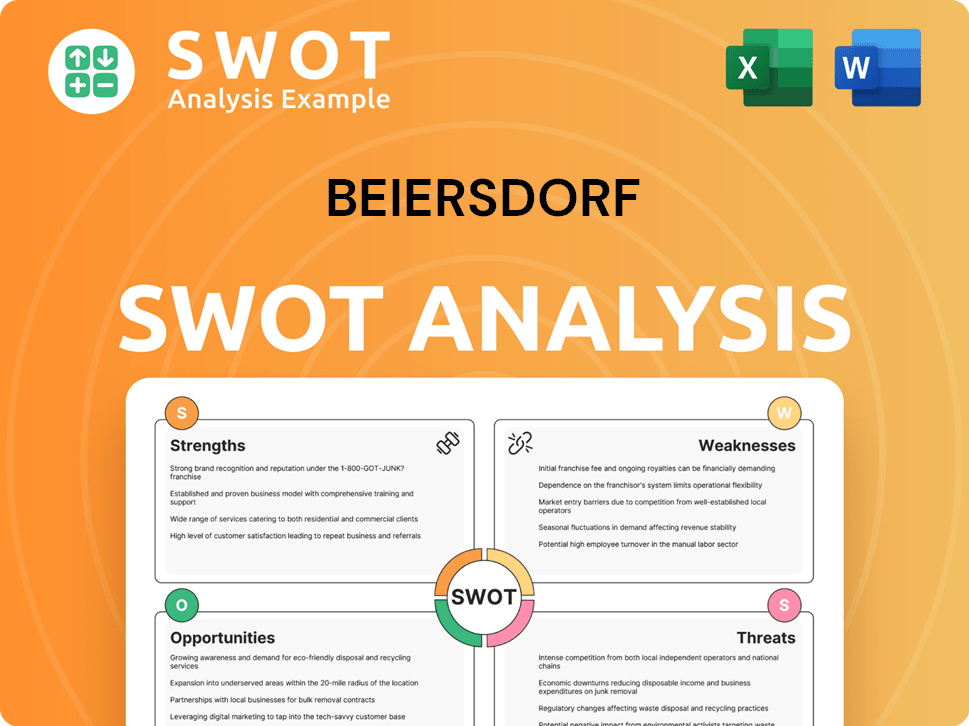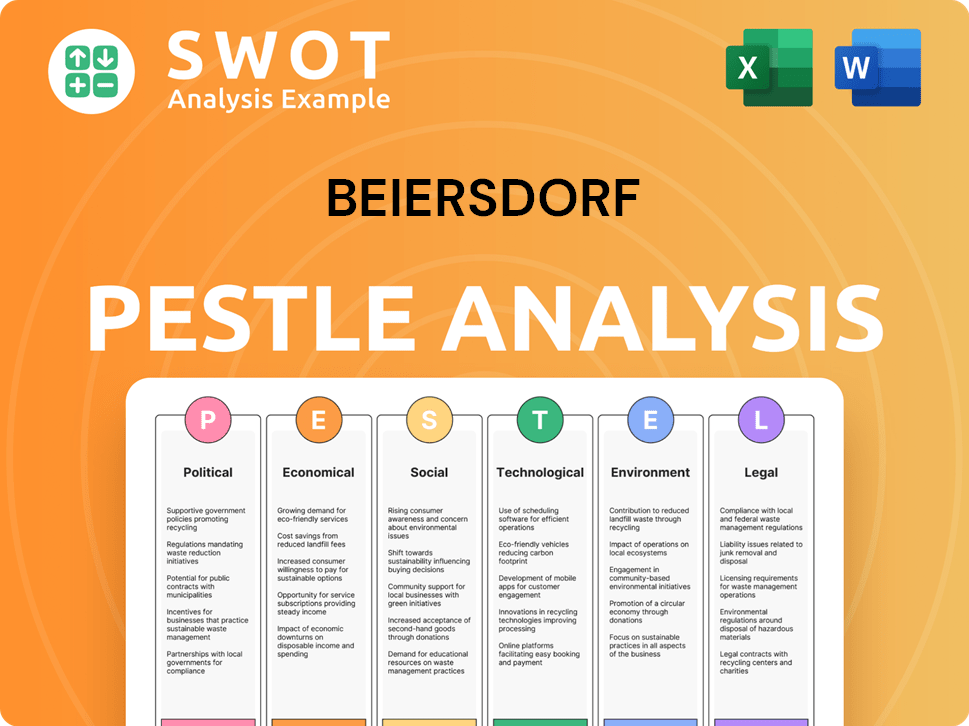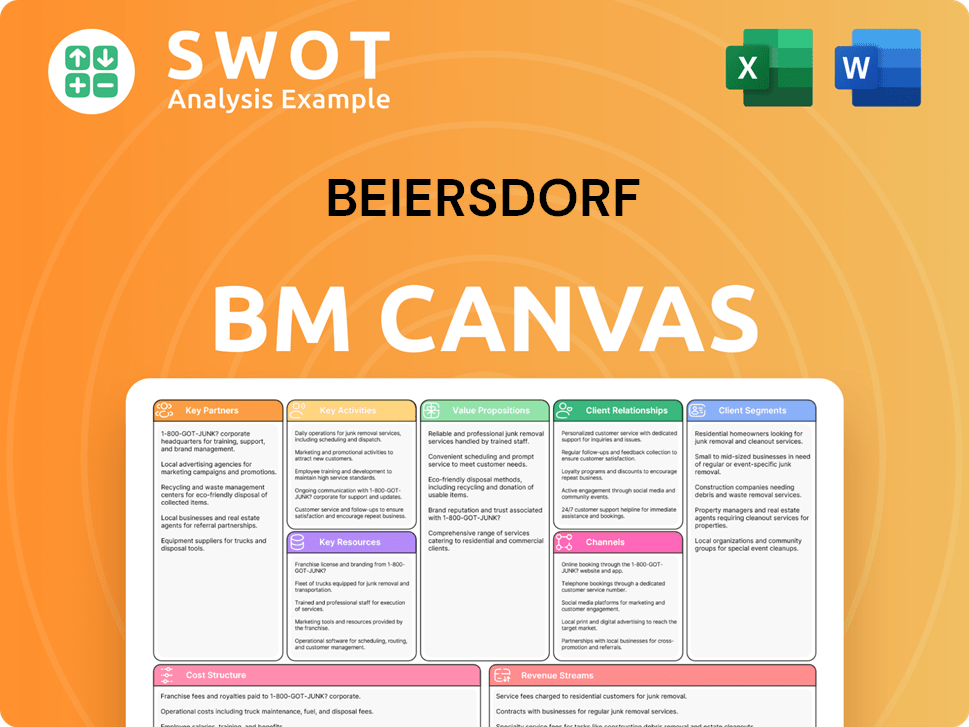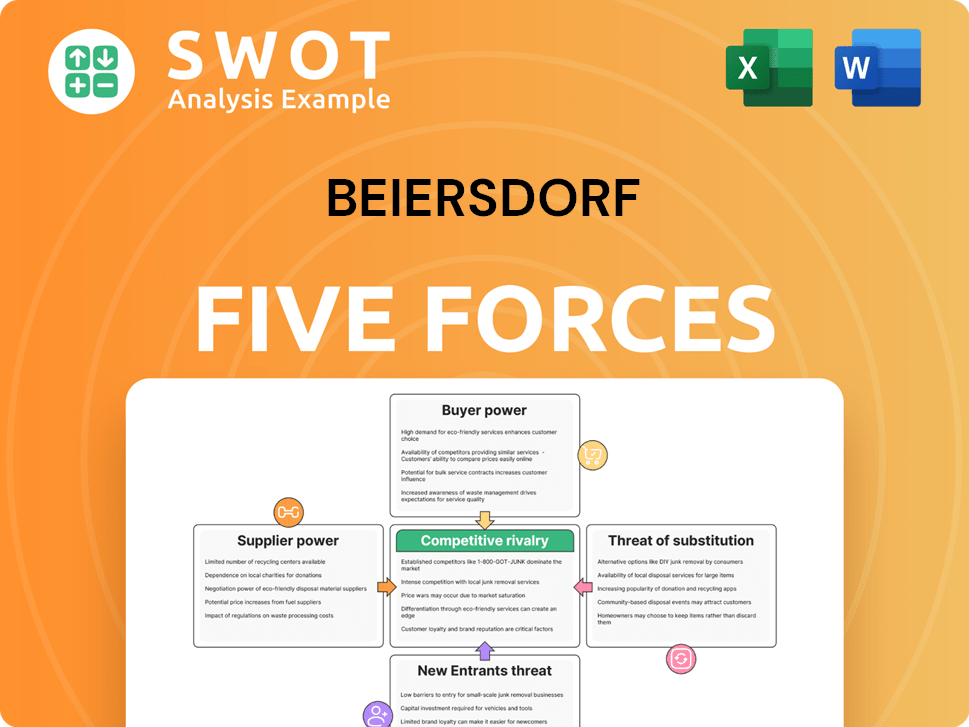Beiersdorf Bundle
Who Really Calls the Shots at Beiersdorf?
Ever wondered who steers the ship behind iconic brands like Nivea and Eucerin? The ownership structure of a company is more than just a legal formality; it's the blueprint for its future. Understanding Beiersdorf SWOT Analysis and its ownership provides a crucial lens through which to view its strategic direction and market performance.

This exploration into the Beiersdorf company ownership unveils the influence of key shareholders, the legacy of its founders, and the impact of its parent company. Knowing who owns Beiersdorf provides valuable insights into its corporate governance, strategic priorities, and its ability to navigate the competitive global market. Delving into the Beiersdorf history and its evolving ownership structure reveals how this German powerhouse has maintained its prominence in the personal care industry.
Who Founded Beiersdorf?
The story of the company begins with Paul C. Beiersdorf, who established the firm in 1882. Initially focused on pharmaceutical products, Beiersdorf held complete ownership of the company during its early years. This set the stage for the company's initial direction and laid the groundwork for future developments.
A pivotal moment arrived in 1890 when Oscar Troplowitz, a pharmacist, acquired the company from its founder. Troplowitz's leadership marked a significant shift, driving the expansion of the business. His strategic vision included the development of Nivea in 1911, which became a cornerstone of the company's success. Under Troplowitz's guidance, the ownership remained primarily within his family.
Detailed information about early equity splits, specific shareholding percentages of the initial backers, or detailed agreements like vesting schedules or buy-sell clauses from this period is not publicly available. The early focus on innovation in dermatological and personal care products, particularly under Troplowitz, was reflected in the concentrated ownership, which allowed for prompt decision-making and strategic product development, shaping the company's trajectory.
Paul C. Beiersdorf founded the company in 1882. The initial focus was on pharmaceutical products. The founder held full ownership at the start.
Oscar Troplowitz acquired the company in 1890. Troplowitz was a pharmacist. This acquisition marked a key shift in ownership.
Troplowitz expanded the business rapidly. He laid the groundwork for future success. Nivea was developed in 1911.
Ownership remained largely with Troplowitz and his family. There is no detailed public information on early equity splits. This concentrated ownership facilitated swift decision-making.
The focus was on innovation in dermatological and personal care products. This vision was key during the founding period. This vision was reflected in the ownership structure.
The company started with pharmaceutical products. The development of Nivea was a major milestone. These products set the direction for future growth.
The early history of the company shows a clear path from its founding to its early development. The shift in ownership to Oscar Troplowitz was critical, as he drove the company's expansion and innovation. The concentrated ownership during this time allowed for strategic decisions that shaped the company's future. To understand the current market, it's beneficial to look at the Target Market of Beiersdorf. The company's early focus on dermatological products and the introduction of Nivea were key to its growth. While specific details about early equity and agreements are not available, the vision and leadership of Troplowitz were paramount. The current Beiersdorf owner and Beiersdorf company ownership structure have evolved significantly since these early days.
The company was founded in 1882 by Paul C. Beiersdorf. Oscar Troplowitz acquired the company in 1890, leading to expansion and innovation.
- Early ownership was concentrated, enabling strategic decisions.
- The development of Nivea in 1911 was a major milestone.
- The company's early focus was on pharmaceutical products and dermatological care.
- Details on early equity and agreements are not publicly available.
- The early vision under Troplowitz shaped the company's direction.
Beiersdorf SWOT Analysis
- Complete SWOT Breakdown
- Fully Customizable
- Editable in Excel & Word
- Professional Formatting
- Investor-Ready Format

How Has Beiersdorf’s Ownership Changed Over Time?
The evolution of the Beiersdorf owner structure is marked by key events. Initially a private entity, the company's transformation into a stock corporation (Aktiengesellschaft - AG) in 1922 opened the door for wider ownership. This shift allowed for the introduction of external investors, which changed the dynamics of the company's control and financial structure. Understanding the Beiersdorf history is crucial to grasping the current ownership landscape.
The most significant influence on Beiersdorf company ownership has been the Herz family, primarily through maxingvest ag, the holding company of the Tchibo coffee empire. This has shaped the company's strategic direction and governance over the years. The Beiersdorf parent company, maxingvest ag, has maintained a controlling interest, which has influenced the company's long-term vision.
| Key Event | Year | Impact on Ownership |
|---|---|---|
| Formation as a Stock Corporation (AG) | 1922 | Allowed for broader ownership and public trading. |
| Increasing Influence of the Herz Family | Throughout the 20th Century | Maxingvest ag became the major shareholder, influencing strategic decisions. |
| Ongoing Public Trading | Present | Free float shares available, with institutional and individual investors. |
As of early 2025, maxingvest ag remains the largest single shareholder in Who owns Beiersdorf, holding 51.34% of the voting rights, according to the 2024 annual report. This controlling stake ensures long-term stability and a focus on sustainable growth. Other key stakeholders include institutional investors like BlackRock, The Vanguard Group, and Norges Bank Investment Management, which hold significant portions of the remaining shares. The presence of a controlling shareholder like maxingvest ag has a profound impact on the company's strategy and governance, often ensuring long-term stability and a focus on sustainable growth rather than short-term gains, as is often the case with widely dispersed ownership.
The Beiersdorf owner structure is primarily controlled by maxingvest ag, with a significant free float available on the stock market. Institutional investors and individual shareholders hold the remaining shares. The company's history reflects a transition from private ownership to a publicly traded entity with a controlling shareholder.
- Maxingvest ag: Controlling shareholder.
- Institutional Investors: Significant shareholding.
- Free Float: Publicly traded shares.
- Individual Investors: Holding the remaining equity.
Beiersdorf PESTLE Analysis
- Covers All 6 PESTLE Categories
- No Research Needed – Save Hours of Work
- Built by Experts, Trusted by Consultants
- Instant Download, Ready to Use
- 100% Editable, Fully Customizable

Who Sits on Beiersdorf’s Board?
The Board of Directors of the company, a pivotal element in its governance, reflects the ownership structure of the company. The Supervisory Board, overseeing the Management Board, includes representatives from major shareholders, independent members, and employee representatives. As of the 2024 Annual General Meeting, the Supervisory Board included individuals representing the interests of maxingvest ag, alongside independent experts from various fields. Key figures like Michael Herz and Wolfgang Herz, central to the owning family, hold positions on the Supervisory Board of the company. Understanding the Beiersdorf owner is crucial to grasping the company's strategic direction.
The governance framework ensures that the Supervisory Board maintains oversight of the Management Board, with a structure designed to balance shareholder interests, independent expertise, and employee representation. The composition of the Supervisory Board, including members from maxingvest ag and independent experts, is a direct reflection of the Beiersdorf company ownership and its commitment to long-term strategic alignment. This structure helps in maintaining stability and strategic alignment with the family's long-term vision for the company. For further insight into the competitive environment, consider exploring the Competitors Landscape of Beiersdorf.
| Board Role | Name | Affiliation |
|---|---|---|
| Chairman of the Supervisory Board | Michael Herz | maxingvest ag |
| Member of the Supervisory Board | Wolfgang Herz | maxingvest ag |
| Independent Member | Dr. Petraea Heynike | Independent |
The voting structure of the company generally operates on a one-share-one-vote principle for its ordinary shares. However, the substantial shareholding by maxingvest ag grants them effective control over major strategic decisions. This concentrated voting power means that while other shareholders have voting rights, the Herz family, through maxingvest ag, holds significant influence. There have been no major publicly reported proxy battles or activist investor campaigns that have significantly challenged this established control in recent years. This structure reflects the long-standing influence of its majority shareholder, aiming for stability and strategic alignment.
The Beiersdorf parent company, maxingvest ag, holds a significant stake, influencing strategic decisions.
- The Supervisory Board includes representatives from maxingvest ag and independent experts.
- The Herz family, through maxingvest ag, maintains substantial control.
- The governance structure prioritizes long-term strategic alignment.
- Understanding the Nivea owner is key to grasping the company's direction.
Beiersdorf Business Model Canvas
- Complete 9-Block Business Model Canvas
- Effortlessly Communicate Your Business Strategy
- Investor-Ready BMC Format
- 100% Editable and Customizable
- Clear and Structured Layout

What Recent Changes Have Shaped Beiersdorf’s Ownership Landscape?
In the past three to five years, the ownership structure of the company has remained relatively stable. This stability is largely due to the significant stake held by maxingvest ag, the Beiersdorf company ownership. While there haven't been major shifts in controlling ownership, Beiersdorf has engaged in strategic financial activities. For instance, in 2023, the company completed a share buyback program, repurchasing approximately €500 million worth of shares. This action subtly increased the proportional ownership of the remaining shareholders, including maxingvest ag.
Industry trends, such as the increasing influence of institutional investors and the rise of activist investors, have had a limited direct impact on the core ownership structure of Beiersdorf. This is primarily because of the strong controlling stake. However, these trends do affect expectations regarding ESG (Environmental, Social, and Governance) performance and transparent reporting. Institutional investors increasingly prioritize these factors. Public statements from the company and analysts consistently highlight the stability provided by the current ownership model, which enables a long-term strategic outlook. There have been no public announcements regarding succession plans for the controlling stake or potential changes to privatization or public listing, indicating a continued commitment to the current ownership model.
| Year | Share Buyback Program | Approximate Value |
|---|---|---|
| 2023 | Completed | €500 million |
The company's commitment to its current ownership model suggests a focus on long-term strategic goals. This is supported by the absence of announcements regarding changes to the controlling stake or plans for privatization. The stability in ownership allows for consistent strategic planning and execution.
The ownership structure has remained relatively stable in recent years. maxingvest ag holds a significant stake, ensuring a consistent strategic direction. This stability is crucial for long-term planning and execution within the company.
The share buyback program in 2023, valued at approximately €500 million, subtly increased the proportional ownership of existing shareholders. This financial activity reflects the company's strategic approach to capital allocation. It also demonstrates confidence in the company's long-term prospects.
Institutional investors increasingly focus on ESG performance and transparent reporting. While the core ownership structure remains stable, these trends influence company expectations. This highlights the importance of environmental, social, and governance factors.
There are no public announcements regarding changes to the controlling stake or privatization. This indicates a continued commitment to the current ownership model. The company's focus remains on long-term strategic goals and sustainable growth.
Beiersdorf Porter's Five Forces Analysis
- Covers All 5 Competitive Forces in Detail
- Structured for Consultants, Students, and Founders
- 100% Editable in Microsoft Word & Excel
- Instant Digital Download – Use Immediately
- Compatible with Mac & PC – Fully Unlocked

Related Blogs
- What are Mission Vision & Core Values of Beiersdorf Company?
- What is Competitive Landscape of Beiersdorf Company?
- What is Growth Strategy and Future Prospects of Beiersdorf Company?
- How Does Beiersdorf Company Work?
- What is Sales and Marketing Strategy of Beiersdorf Company?
- What is Brief History of Beiersdorf Company?
- What is Customer Demographics and Target Market of Beiersdorf Company?
Disclaimer
All information, articles, and product details provided on this website are for general informational and educational purposes only. We do not claim any ownership over, nor do we intend to infringe upon, any trademarks, copyrights, logos, brand names, or other intellectual property mentioned or depicted on this site. Such intellectual property remains the property of its respective owners, and any references here are made solely for identification or informational purposes, without implying any affiliation, endorsement, or partnership.
We make no representations or warranties, express or implied, regarding the accuracy, completeness, or suitability of any content or products presented. Nothing on this website should be construed as legal, tax, investment, financial, medical, or other professional advice. In addition, no part of this site—including articles or product references—constitutes a solicitation, recommendation, endorsement, advertisement, or offer to buy or sell any securities, franchises, or other financial instruments, particularly in jurisdictions where such activity would be unlawful.
All content is of a general nature and may not address the specific circumstances of any individual or entity. It is not a substitute for professional advice or services. Any actions you take based on the information provided here are strictly at your own risk. You accept full responsibility for any decisions or outcomes arising from your use of this website and agree to release us from any liability in connection with your use of, or reliance upon, the content or products found herein.